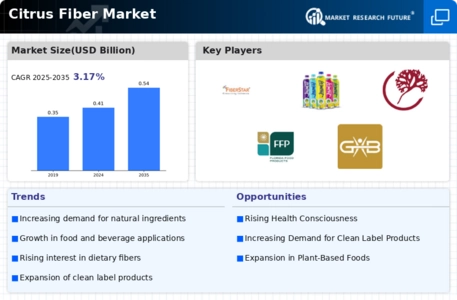Top Industry Leaders in the Citrus Fiber Market

Strategies Adopted by Citrus Fiber Key Players
The competitive landscape of the citrus fiber market is characterized by a dynamic interplay of key players, each employing distinct strategies to gain market share and navigate industry challenges. As of 2023, several factors contribute to the competitiveness within the market, including the presence of established industry leaders, the emergence of new players, and ongoing developments that shape the overall landscape.
Key Players:
- Fiberstar Inc (United States)
- CP Kelco Inc (United States)
- Herbafoods Ingredients GmbH (Germany)
- Lemont (China)
- FUYAN PHARM Inc. (China)
- Ceamsa(Spain)
- Florida Food Products Inc. (United States)
- Golden Health (China)
- Cifal Herbal Private Ltd (India)
- Nans Products (India).
To maintain or enhance their market positions, key players in the citrus fiber market employ a range of strategies. These strategies often involve product innovation, strategic partnerships, acquisitions, and geographical expansions. For instance, companies invest in research and development to introduce novel citrus fiber applications, tapping into diverse market segments. Collaborative ventures and acquisitions are also common strategies to strengthen supply chains and broaden market reach.
Factors for Market Share Analysis:
Market share analysis in the citrus fiber sector involves evaluating several factors. Product quality, pricing strategies, distribution efficiency, and brand reputation are key determinants. Additionally, the ability to adapt to regulatory changes, sustainability practices, and responsiveness to consumer preferences are becoming increasingly crucial factors for maintaining and expanding market share.
New and Emerging Companies:
The citrus fiber market has witnessed the entry of new and emerging companies seeking to capitalize on growing consumer demand for natural and functional ingredients. These companies often introduce innovative products or offer specialized solutions, challenging the market dominance of established players. The agility of these newcomers, coupled with their focus on niche markets, contributes to the overall vibrancy of the citrus fiber industry.
Industry News and Current Companies:
The citrus fiber market is subject to a stream of industry news and updates. Ongoing developments, such as mergers, acquisitions, and partnerships, play a pivotal role in shaping the competitive landscape. Companies are keenly observed for their response to market trends, regulatory changes, and global economic factors. The ability to adapt swiftly to such external influences determines the resilience and competitiveness of market participants.
Investment Trends:
Investment trends in the citrus fiber market reflect the industry's growth potential and evolving consumer preferences. Investors are drawn to companies that demonstrate a commitment to sustainability, innovation, and market expansion. Strategic investments in research and development, production facilities, and marketing initiatives are indicative of a company's proactive approach to securing a competitive edge.
Overall Competitive Scenario:
The overall competitive scenario in the citrus fiber market is characterized by intense rivalry among key players vying for market share. The focus on product differentiation, cost competitiveness, and sustainable practices has heightened competition. Market consolidation through mergers and acquisitions is a recurring theme, as companies seek to strengthen their positions and capitalize on synergies.
Recent Developments
The citrus fiber market experienced notable developments that underscored the industry's dynamic nature. Several key players announced strategic partnerships to enhance their capabilities in sourcing raw materials or expanding their distribution networks. Product launches with enhanced functionalities, such as improved solubility or texture enhancement, were prominent across the industry.
Additionally, regulatory compliance and sustainability initiatives gained momentum in response to increasing consumer awareness. Companies were quick to adapt their strategies to align with evolving standards and consumer expectations, further intensifying the competitive landscape.

- Beta
Beta feature

